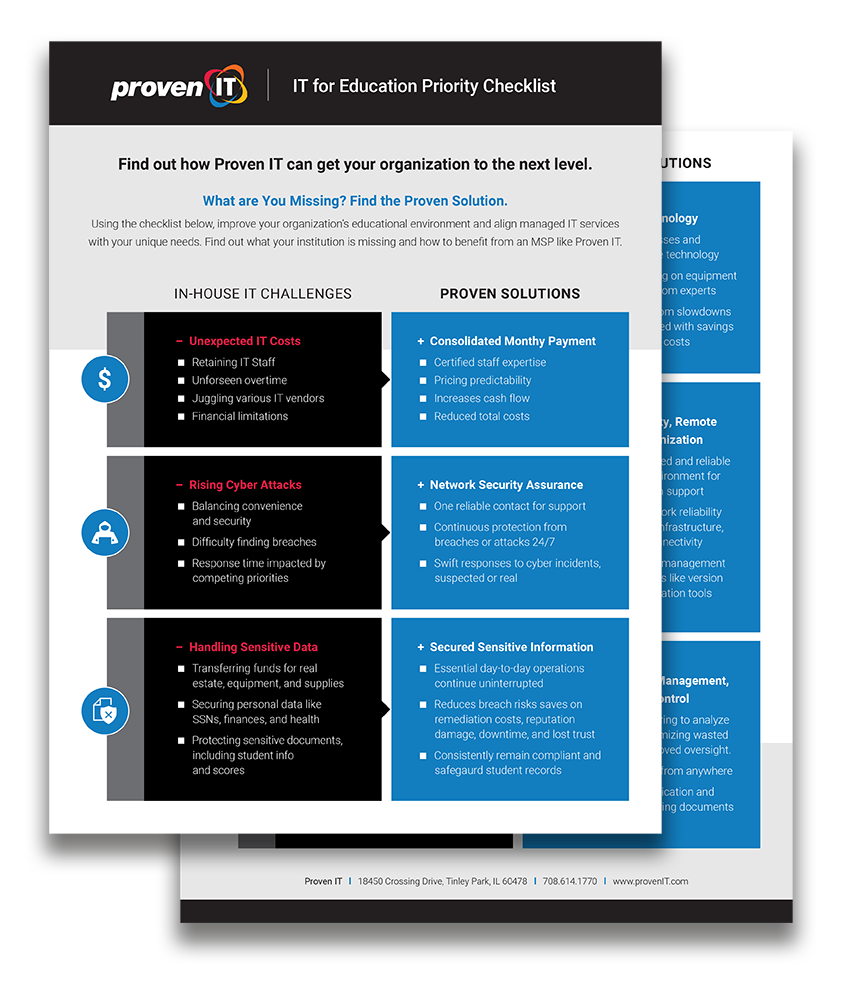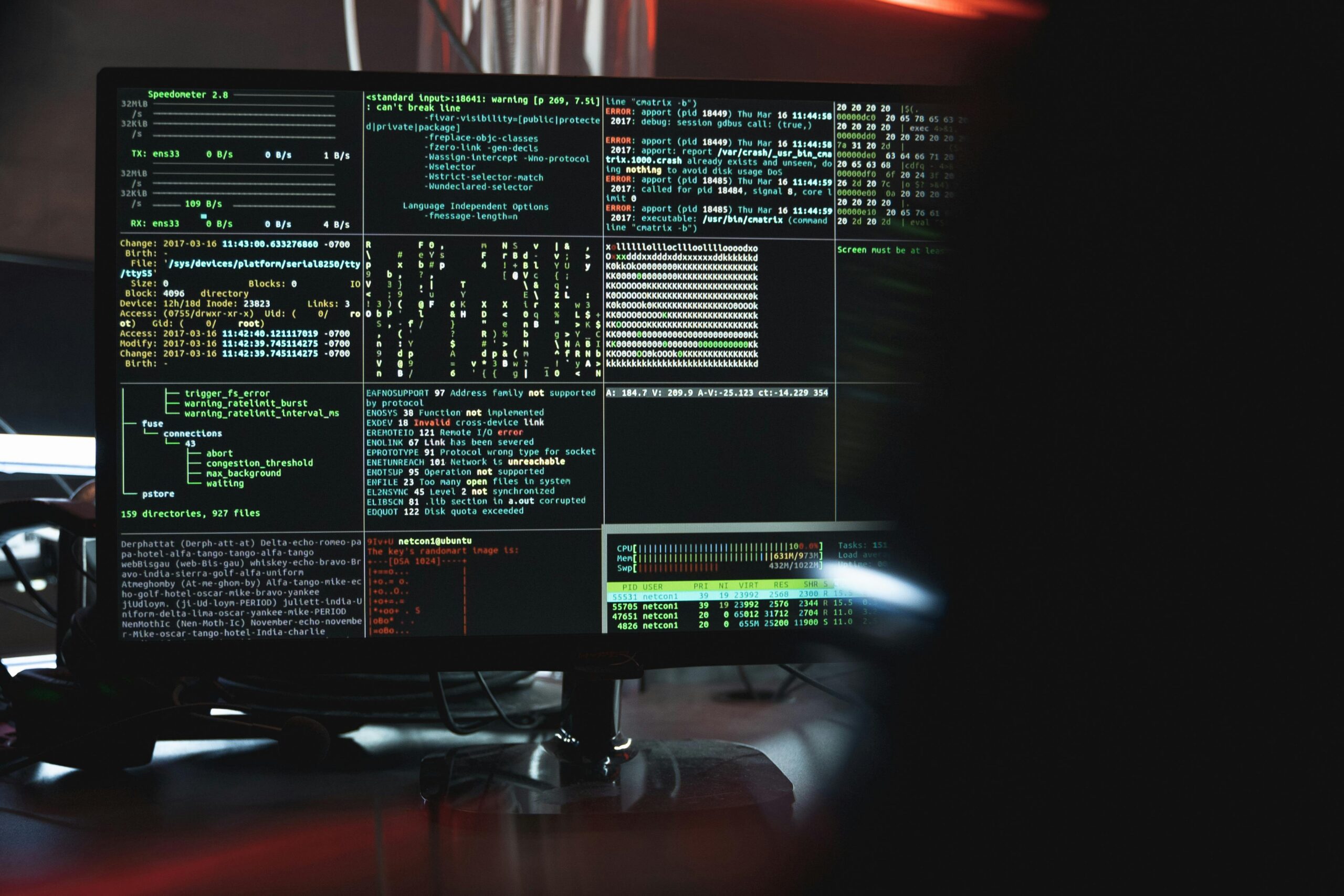The rise of digital technology in education has greatly benefited schools by streamlining administrative tasks, improving communication, and providing students with invaluable access to information. However, this increasing reliance on technology also exposes schools to significant cybersecurity risks.
Among the most common and potentially damaging threats are phishing and ransomware attacks. These attacks not only target valuable school data but also endanger the safety and privacy of both staff and students. As technology becomes more integrated into education systems, adopting proactive cybersecurity for schools helps ensure their safety and continuity.
This blog will tackle phishing and ransomware threats, their impact on schools, and key steps to protect your institution. We’ll also cover the importance of cybersecurity training for employees and how Proven IT’s support for schools can help you stay secure!
Understanding Phishing and Ransomware in Schools
Between July 2023 and December 2024, 82% of K-12 schools experienced a cyber incident, totaling over 9,300 confirmed cases across approximately 5,000 institutions. This alarming rise highlights how cybercriminals increasingly target schools, with phishing and ransomware being the most prevalent threats.
What Are Phishing Attacks?
Phishing attacks occur when cybercriminals impersonate legitimate entities, such as school administrators, staff, or trusted service providers, to steal sensitive information. These attackers commonly use emails, fake websites, or phone calls to deceive individuals into revealing confidential details.
In 2024, phishing attacks accounted for 39.6% of all email threats, making them the most common email-based attack. This trend is especially concerning given that a six-year-long undetected phishing campaign targeted over 150 organizations, with educational institutions comprising 52.8% of the victims.
What is Ransomware in Schools?
Ransomware is a type of malware that encrypts a school’s data. Cybercriminals typically gain access to the school’s system through phishing emails or exploiting vulnerabilities in outdated software. Once the ransomware is executed, it encrypts important files and demands payment for the decryption key.
Ransomware in schools is particularly concerning because it can lock down critical information, including student records, academic materials, and administrative data. In some cases, cybercriminals threaten to delete or release the data publicly if the ransom is not paid.
In 2024, schools and universities experienced 116 confirmed ransomware attacks, affecting an estimated 1.8 million records, with cybercriminals demanding an average ransom of $847,000.
Why Are Schools Being Targeted by Cyberattacks?
Cybercriminals often target schools because they store sensitive data, including student records, staff credentials, and financial information. Many schools also face limited IT resources and a lack of comprehensive cybersecurity training for employees, which makes them more vulnerable to cybersecurity risks.
In December 2024, PowerSchool, a major education software provider serving over 60 million students worldwide, suffered a significant data breach. Hackers exploited compromised credentials to access sensitive data, including names, Social Security numbers, medical alerts, and academic records.
PowerSchool paid an undisclosed ransom, believing the data was deleted after receiving a video as proof. However, by May 2025, attackers resumed extortion efforts, threatening to release the data unless additional ransoms were paid. Some compromised records date back to 1985, raising long-term data misuse concerns.
The incident highlights the vulnerabilities in educational technology and the critical need for stronger cybersecurity in schools.

The Impact of Phishing and Ransomware in Schools
Both phishing and ransomware attacks can have severe consequences for educational institutions. Let’s break down the impact on both staff and students, highlighting the importance of implementing cybersecurity for schools:
- Disruption of Learning: A ransomware attack can shut down critical systems like learning management, student information, and email platforms. Without access to these tools, lessons, coursework, and administrative tasks are halted, causing days or weeks of lost productivity and delays in curriculum and grading.
- Loss of Sensitive Data: Phishing and ransomware attacks can expose or steal sensitive data, such as student records and personal information. This can lead to identity theft and legal issues, with data potentially sold on the dark web or misused for financial gain.
- Financial Consequences: Ransomware usually involves untraceable cryptocurrency, and paying doesn’t guarantee you’ll get the decryption key. As a result, schools may face further costs to restore data, rebuild systems, and strengthen cybersecurity, adding to the financial burden, especially for schools with limited budgets.
- Reputational Damage: A successful cyberattack can severely damage a school’s reputation, undermining trust with parents, students, and staff. This breach of confidence can take years to repair, affecting enrollment, public perception, and even relationships with donors and stakeholders.
- Legal Implications: Schools are legally required to protect student and staff information under laws like FERPA (Family Educational Rights and Privacy Act) and various state regulations. A breach could result in lawsuits, fines, and costly legal settlements.
Protect Your Staff and Students with Proven IT’s Cybersecurity for Schools!
Schedule a 30-minute discovery meeting to explore how Proven IT can support your school’s technology needs with cybersecurity solutions that can protect your institution from phishing and ransomware attacks!
How to Prevent Cyberattacks in Schools With Reliable Cybersecurity
Preventing phishing and ransomware attacks requires a comprehensive approach that combines technology, cybersecurity training for employees, and proactive planning. To strengthen cybersecurity for schools and prevent these cyberattacks, here are some practical steps your school can take:
1. Conduct Cybersecurity Training for Employees
Human error is a common employee cybersecurity risk and a leading cause of successful cyberattacks. One of the best ways to mitigate this risk is through cybersecurity training for employees. All staff members, from teachers to administrators, must be trained to identify common phishing tactics, such as suspicious email attachments or deceptive links.
To ensure effectiveness, the cybersecurity training for employees should include practical scenarios and simulations. Ongoing security awareness, coupled with follow-up sessions, helps reinforce these skills and ensures continuous vigilance within the organization.
Your school can also significantly reduce the risk of attacks by continuously educating employees on safe online practices and keeping them updated on the latest threats.
2. Enforce Multi-Factor Authentication (MFA)
Multi-factor authentication (MFA) adds an additional layer of security by requiring users to provide more than just a password to access critical systems (e.g., a text message code or authentication app). Even if an attacker successfully steals a staff member’s login credentials, they will still need to bypass the second layer of authentication.
3. Perform Regular System Updates and Patches
Outdated software is one of the easiest ways for cybercriminals to exploit vulnerabilities and launch a ransomware attack. Your school should have a routine schedule in place for updating all software, including operating systems, anti-virus programs, and other critical tools. This ensures that security patches are applied promptly.
4. Back Up Critical Data
In the event of a ransomware attack, having a secure, off-site data backup is crucial. Cloud-based backups provide a reliable solution, offering remote access and protection from local network threats. Regular backups ensure that if ransomware encrypts files, your school can quickly restore its systems and minimize downtime. To further safeguard against attacks, these backups should be encrypted and kept disconnected from the main network.
5. Implement Network Segmentation and Access Control
Your school should implement network segmentation, which involves separating sensitive data from other network parts. This involves dividing the network into smaller, isolated sections, where sensitive data is stored in separate segments from less critical areas.
For example, systems that store grades or financial information should be isolated from general administrative tools. So if an attacker gains access to a less critical part of the network, they cannot easily move laterally to access sensitive data.
Also, access controls must be strictly enforced to ensure that only authorized staff can access sensitive systems and data. Implementing role-based access controls (RBAC) along with the principle of least privilege helps restrict access to only what’s necessary.
Logging and monitoring should be implemented to further enhance security, track data access, and trigger alerts for unauthorized attempts. This enables the IT team to respond quickly and contain potential threats.
6. Deploy Endpoint Protection Solutions
Endpoint security tools, such as antivirus and anti-malware software, help schools monitor all devices (laptops, tablets, desktops) connected to their network. These tools detect unusual behavior that might signal a phishing attack, malware infection, or ransomware attempt, enabling IT teams to respond quickly before threats spread.
For example, advanced endpoint protection systems, powered by machine learning, are designed to detect new and emerging threats by continuously analyzing patterns of normal system behavior. When an anomaly is detected, these systems can automatically isolate the compromised device from the network, preventing further spread of the attack and immediately notifying the IT team.
7. Monitor for Suspicious Activity
Proactive monitoring of network traffic and system behavior can help detect potential phishing or ransomware attacks before they escalate. With 24/7 threat detection tools in place, your school can pinpoint unusual activities, such as unauthorized file access or strange login attempts, which may signal a cyberattack. Early identification enables the IT team to quickly act and limit the attack’s impact before it spreads.
Get a free Technology Solutions for Education Checklist!
If you’re looking to enhance your school’s technology infrastructure, our FREE Technology Solutions for Education Checklist can guide you in prioritizing and implementing the right solutions!


The Benefits of Proactive Cybersecurity for Schools
Proactively addressing security threats with secure and reliable cybersecurity for schools not only helps prevent cyberattacks but also ensures your school remains resilient in the evolving cyber risks.
At Proven IT, we understand the complexities of cybersecurity for schools and the unique challenges educational institutions face when protecting their staff and students. Our team of experts has years of experience providing trusted and dependable cybersecurity for schools.
Here’s why schools choose Proven IT:
- Enhanced Security and Data Protection: Our proactive approach to cybersecurity for schools safeguards sensitive student and staff data from threats like phishing and ransomware. With continuous monitoring and threat detection, potential breaches are identified and prevented before they occur, ensuring the safety of valuable information.
- Cost Savings and Predictable Budgeting: Outsourcing cybersecurity for schools to We eliminate the need for costly in-house IT hires, reducing turnover and associated expenses. With fixed, predictable costs, your school can manage its budgets more effectively.
- Compliance with Data Privacy Regulations: We help schools stay compliant with state and federal data privacy regulations, ensuring that sensitive information is protected. This reduces the risk of fines or legal complications stemming from data breaches or non-compliance.
- Boosted Confidence and Community Trust: Strengthening cybersecurity for schools helps build parent and staff confidence in the institution’s technology. Your school can foster a positive reputation and maintain community trust by protecting student data and ensuring seamless digital learning.
Gear Up for the Next School Year with Reliable Cybersecurity for Schools!
Don’t wait for an attack to disrupt your school’s operations. Strengthen your defenses with expert cybersecurity for school from Proven IT! Contact us today to learn how we can help you create a secure, protected environment for your staff and students!






